Euprosthenops Australis [Funnel Nursery-Web Spider]
Hello, Hivers!
Spring is officially here in the Karoo and that means the spoods have come out! The drought of a near-spiderless winter is over and I've spotted several new species as well, including a Hyllus sp. jumping spider! She was huge, about 1cm in body length. But that's a post for another day.
We're returning to the Nursery-Web spiders and this time it's with one of the funnel weaver ones. Not to be confused with the Funnel-Web spiders! Those are mygalomorphs (primitive spiders) with very large chelicera and they're not in my area as far as I'm aware.
Euprosthenops is one of the few genera of Pisaurids that are web-dwelling instead of ground-dwelling. They begin their web lives from the moment they leave their mother's web, and that's where they'll stay until they die, provided they're not forced to make a new web somewhere else.
Unlike the previous Pisaurid I wrote about, Euprosthenops spiders are huge! Seriously, they are insanely large for true spiders (araneaemorphs), with females reaching 5cm in body length alone.
• EUPROSTHENOPS AUSTRALIS •
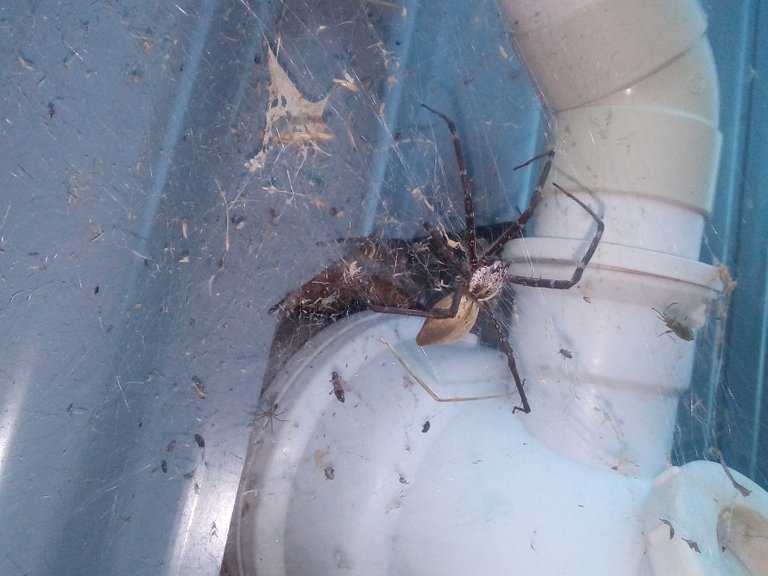
This gorgeous female is known as the African Funnel Nursery-Web spider. The scientific name, Euprosthenops australis, points to this species having been found in "the south". The genus is quite wide-spread across South Africa, having been recorded in all 9 provinces.
This female was very well-fed, as you can see by her rounded and fit-to-burst abdomen. Her web was large and extensive and the silk very strong. I had to tease her out using a stick of veld grass and brushing it on her web to make her think it was an insect to get her to come out of her web funnel.
I had to do this several times before I could nab photos of her because my cat decided he needed attention right then and there and he kept brushing against the spider's anchor lines. Darned cat. Fortunately, he isn't interested in hunting the spiders here. Unless they're Pholcids. For some reason, he has a gripe against Pholcids.
• GENUS •
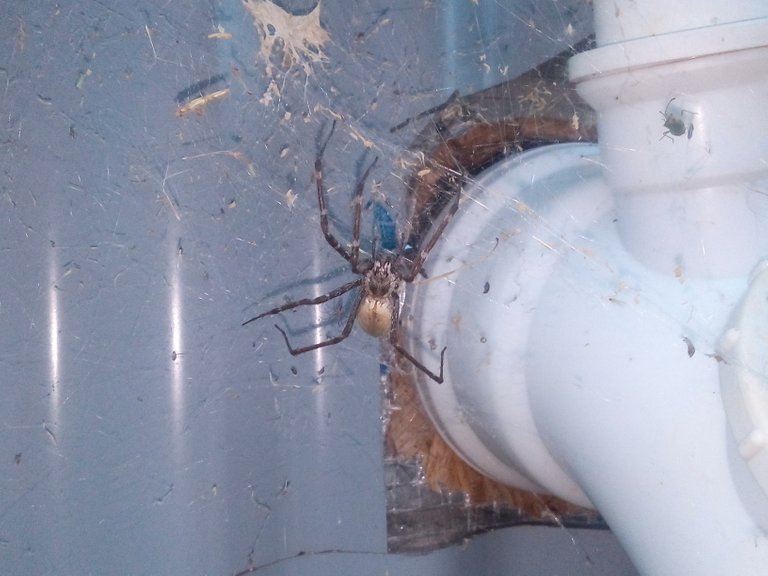
Identifying which genus this female belonged to was very easy. Simply, because of her large size. Her eye pattern indicated that she was a Pisaurid. Her size indicated the genus Euprosthenops.
There are three known species of this genus in South Africa, all of them looking almost the same with slight variations. E. australis, for instance, has a plain-looking dorsal abdomen, whereas the others have a pattern. By far, the easiest spider I've identified. Not the easiest to get photographed or close to, however.
Even if they weren't so skittish in nature, they are considered medically insignificant like all Pisaurids. Though, their bites can be painful due to their large chelicera.
• DESCRIPTION •
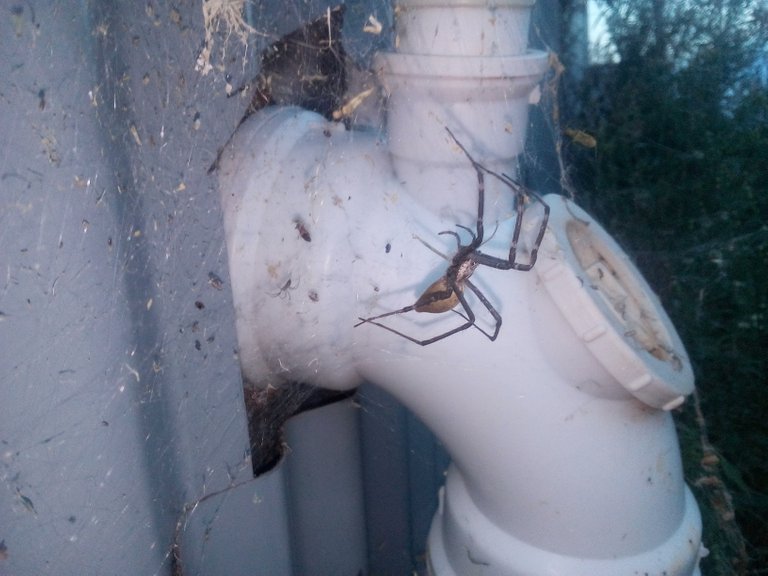
Taxon:
- Class: Arachnida
- Order: Araneae
- Infra-Order: Araneamorph (true spiders)
- Family: Pisauridae
- Genus: Euprosthenops
- Species: E. australis
Female
About 50mm in body length. Leg span of approximately 120mm diagonally.
Cephalothorax:
Greyish brown carapace, darker oval marking in middle with light stripe running through centre, dark V-like crown marking above eyes. Dark brown X marking connecting each eye, which are also in an X formation. Long brown jaws with small fangs. Light brown edge on sides of carapace.
Abdomen:
Long abdomen tapering toward spinnerets, yellowish brown with darker fading near tip, and short black stripe in centre anterior dorsal, small black spot on either side of stripe. Ventral abdomen brown with darker V marking in middle extending and tapering to spinnerets.
Legs:
Long dark greyish brown legs with light sparse hairs and light bands near joints. Spines on all legs from femur to metatarsus.
Male
Unknown.
• ABOUT THE GENUS •
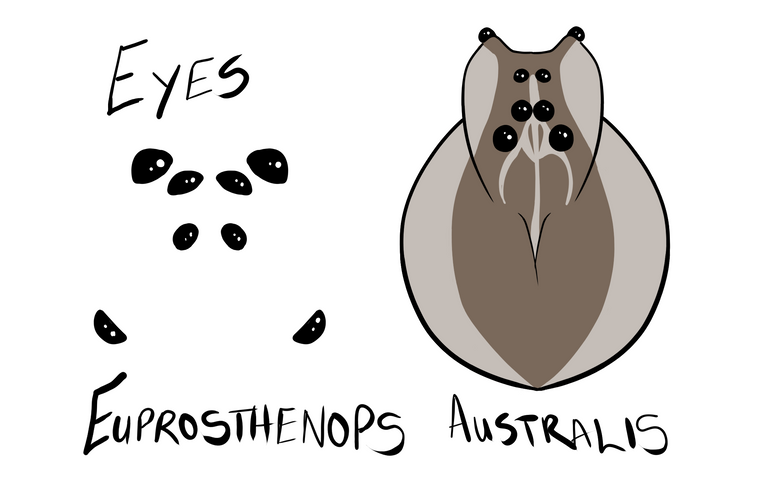
Euprosthenops spiders are graceful, fast, and agile on their webs. They're also, along with other Pisaurids, maternal animals who carry their egg sac in their chelicera and use their pedipalps and abdomen to keep it secure.
Their webs are contructed in a messy manner with a funnel in which the spider can retreat and secure her egg sac in when her young are about to hatch. Euprothenops are avid hunters, responding to prey signals on their webs with speed.
Furthermore, the silk of Euprosthenops has great tensile strength and is often used in studies concerning the use of spider silk in various industries, including medicine and production.
• NOTES •
I was surprised to find most of this female's spiderlings still on her web, considering the juveniles were well into their growth and not hatchlings anymore. Also surprising was how the female caught and wrapped prey but left it secured to her web for her young to consume.
It was remarkable to watch her, seeing this amount of maternal care from a spider. There was even a sub-adult female from this female's previous brood who still lived on, or at the least built her own web attached to her mother's web. The mother didn't attack this sub-adult, or even bother to show she knew of her existence, though she must have known through the vibrations on the web.
But the mother here also didn't provide food for the sub-adult. It looked more like an understanding to live and let live between the two females. The mother, however, was at least 3 times larger so she could have eaten the sub-adult at any time. Perhaps the maternal care of Euprosthenops spiders is still not fully known and understood.
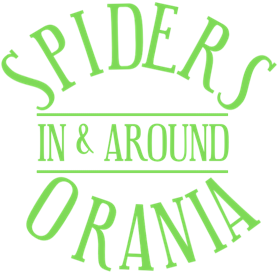
This was such an interesting read! I had no idea of the maternal care these spiders had. Then again, I am not the biggest fan of spiders overall. I respect them and their role in the ecosystem though. If I find one in the house, I always try to get it out unharmed. I don't have a perfect track record in that regard, unfortunately! Sometimes I spook and then my husband will just storm in and squash it instinctively.
I am proud to say that I did once move a giant rain spider out successfully, while my husband was the one hiding. Steve as I called him was very chill though. We had an understanding. As long as he (though it may well have been a she, I am no expert like you) didn't make any sudden unexpected movements we would both get through this just fine. I coaxed him off the curtain and into a bucket (a big bucket, just in case) and deposited him at the very furthest point in the garden.😂
It's the little things that count! Sometimes it's unavoidable and/or unintentional, but spiders die from so many other things that actively hunt them. So relocating one is a massive help!
what a beautiful spider and what a nice description! You talk as an entomologist! Did you have biology classes? or you learned reading by yourself??

!1UP
Thank you! Self-taught and amateur, though I'd like to one day get a degree in arachnology if the funds permit it.
You have received a 1UP from @gwajnberg!
@stem-curator, @neoxag-curator
And they will bring !PIZZA 🍕.
Learn more about our delegation service to earn daily rewards. Join the Cartel on Discord.